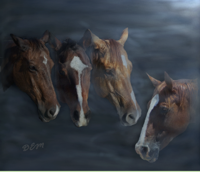
Turning
[As additional resources, links to book reviews and book purchasing information can be found beneath the quotations when this information is available.]
"At first, all changes of direction should be taught at the walk."
James Fillis, Breaking and Riding
Buy Book
(Top)
"The volte is, in fact, only a pirouette described on a large circle."
James Fillis, Breaking and Riding
Buy Book
(Top)
"To turn to the right, we should lightly draw the off snaffle rein with the right hand to the right, and not towards our body, so as not to stop the horse....[I]f, at the moment when the animal yields his head and neck to the pull of the right rein, we slacken the hand, while supporting the legs, we thereby force the right leg to take a pace as long as usual and shall consequently avoid the period of arrest, by obliging the croup to follow the shoulders."
James Fillis, Breaking and Riding
Buy Book
(Top)
"The active inside leg, which bends the bow and creates impulsion, should be used at the girth in harmony with the horse's rhythm....He does not want to bend his body around an iron bar, but will happily curl around a soft, sensitive leg — the one you get from leg–lengthening."
Sally Swift, Centered Riding
Read Review
Buy Book
(Top)
"In order to put pressure on the neck, the outside hand can come above the crest of the horse's neck, but never across it."
Sally Swift, Centered Riding
Read Review
Buy Book
(Top)
"...drop your outside leg back from your hip joint.
Sally Swift, Centered Riding
Read Review
Buy Book
(Top)
"...the outside stubby leg lies positively and quietly farther behind the girth. With the top of that leg rolled forward and the rest of it stretched back, you will clearly feel what is meant by 'the flat of the thigh against the horse.'"
Sally Swift, Centered Riding
Read Review
Buy Book
(Top)
"Your body axis should never tip to the side more than your horse's axis."
Sally Swift, Centered Riding
Read Review
Buy Book
(Top)
"Crooked saddles or riders cause horses to duck out of or become unbalanced in turns."
Joyce Harman, DVM, MRCVS, The Horse's Pain-Free Back and Saddle-Fit Book
Read Review
Buy Book
(Top)
"The marriage of inside and outside aids creates a horse that bends while turning along a prescribed line. Your inside rein asks you horse to look in the direction he's going and your inside leg asks him to bend through his side. Your outside rein supports and limits the amount of bend in your horse's neck, Your outside leg prevents his hindquarters from swinging out and, therefore, helps bend his body around your inside leg."
Jane Savoie, Cross-Train Your Horse, Simple Dressage for Every Sport
Read Review
Buy Book
(Top)
"As you ride circles and turns, be sure to look directly between your horse's ears."
Jane Savoie, Cross-Train Your Horse, Simple Dressage for Every Sport
Read Review
Buy Book
(Top)
"For a large circle or loop it [your outside leg] only comes back an inch or two. On a very small circle, the outside leg might be a few inches behind the inside leg."
Jane Savoie, Cross-Train Your Horse, Simple Dressage for Every Sport
Read Review
Buy Book
(Top)
"Remember that horses are more flexible in the neck than elsewhere in the spine, so be sure to limit and control the amount of bend in the neck by supporting with the outside rein."
Jane Savoie, Cross-Train Your Horse, Simple Dressage for Every Sport
Read Review
Buy Book
(Top)
"A good rule of thumb is to go into the corner only to a depth that your horse can handle without losing his rhythm and balance."
Jane Savoie, Cross-Train Your Horse, Simple Dressage for Every Sport
Read Review
Buy Book
(Top)
"As it must be counter-productive to teach a horse to turn by pulling his head and neck round so that his body has to follow, we should eradicate all thoughts of riding the horse from the forehand at the very onset of training."
Sylvia Loch, The Classical Rider
Read Review
Buy Book
(Top)
"The greatest obstacle to a good canter circle is when the rider's upper boy turns too much to the inside or too strong an aid is given with the inside rein. This has the effect of blocking the horse through the shoulders and may prevent the horse from engaging his inside hind, an absolute requisite of a balanced circle."
Sylvia Loch, The Classical Rider
Read Review
Buy Book
(Top)
"Too often, in turns and circles, riders tend to collapse to one side, which will create huge problems for the horse if he is to keep turning correctly so that his hind feet continue to step into the tracks of the forefeet."
Sylvia Loch, The Classical Rider
Read Review
Buy Book
(Top)
"...look ahead where you are going to go by turning your whole upper body."
Mary Twelveponies, Everyday Training: Backyard Dressage
Read Review
Buy Book
(Top)
"If the horse makes the circle too small, avoid the temptation to guide him out with the reins. Instead, drive with your inside leg and hip, using the whip as needed."
Mary Twelveponies, Everyday Training: Backyard Dressage
Read Review
Buy Book
(Top)
"...in neckreining correctly you never use pressure on the horse's neck...."
Mary Twelveponies, Everyday Training: Backyard Dressage
Read Review
Buy Book
(Top)
"The only way that neckreining differs from two-fisted riding is that you let your outside hand cross the horse's withers slightly — an instance of using the indirect rein on the outside."
Mary Twelveponies, Everyday Training: Backyard Dressage
Read Review
Buy Book
(Top)
(Top)